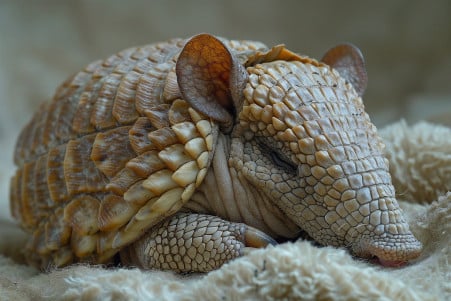Can You Actually Have a Pet Red Panda? A Look at the Laws and Hurdles
16 May 2024 • Updated 14 May 2024

Have you ever wanted to own a red panda? As tempting as it may be, the truth is that it's nearly impossible to own a red panda and, in most places, illegal without the proper permits and licenses. Red pandas are an endangered species that need a level of care and a diet that's so specialized that it's nearly impossible to provide in a home setting. For most people, the best way to interact with red pandas is to visit them in a zoo or wildlife sanctuary.
This article will review studies by wildlife biologists, exotic animal veterinarians, and conservation groups to discuss the laws and hurdles of owning a red panda. By presenting the facts in an unbiased way, you can make an educated decision about whether or not it's realistic or even ethical for the average person to try to keep a red panda as a pet. This article will also cover the ethical and practical issues that come with keeping red pandas and other endangered animals as pets.
Can you own a red panda?
The Legal Landscape: Laws and Limits on Red Panda Ownership
Red pandas are covered by international and national laws, which means that in most cases, it is illegal to own one. According to the Red Panda Network, red pandas are listed under the Convention on International Trade in Endangered Species of Wild Fauna and Flora (CITES), which means that they can't be transported across international borders for the purpose of being someone's pet. If you see a red panda for sale, it's likely that it was captured illegally through poaching or wildlife trafficking, which is one of the reasons that red panda populations are dropping.
That said, there are exceptions for accredited zoos, circuses, and conservation breeding programs that have the right permits and licenses. As FindLaw notes, many states have exceptions in their exotic animal bans for people who are exhibiting animals or using them for scientific or educational purposes. That said, laws about exotic animals can vary widely from state to state and even from one local jurisdiction to another, and some states and localities have much stricter laws than others.
It's important to keep up with the laws and proposed laws about exotic animal ownership in your area. According to Paradise Wildlife Park, the illegal pet trade, which is often fueled by demand on social media, is one of the biggest threats to the already endangered red panda species. If you are caught with a red panda without the proper permits, you could face steep fines and even jail time. It's important to make sure that conservation is the priority when it comes to these special animals.
The Red Panda's Specialized Diet and Ecology
Red pandas are found in the eastern Himalayas, with their natural habitat spanning parts of China, Nepal, Bhutan, and India. WWF notes that they live in temperate broadleaf and mixed forests at elevations between 2,200 and 4,800 meters. They are almost entirely herbivorous, with bamboo making up as much as 95% of their diet. Red pandas have evolved a number of specializations, such as large skulls, strong jaws, and a "thumb-like" radial sesamoid bone that enables them to effectively grip and consume bamboo leaves and shoots. As the San Diego Zoo explains, they can spend up to 12 hours a day "grazing" in order to meet their high caloric requirements.
Red pandas are also highly skilled climbers, using their rotating ankles and semi-retractable claws to move nimbly through the forest canopy. According to the San Diego Zoo, they are active for 45-49% of the day, with the rest of their time spent resting and sleeping in trees. They communicate through a range of vocalizations, including distress, alarm, and mating calls, and they also use scent marking, which involves rubbing secretions from their anal glands on objects. These specializations in diet and ecology must be taken into account when considering the welfare of red pandas in captivity.
Conservation Efforts: How Red Pandas Are Being Saved
Red pandas are listed as endangered by the International Union for Conservation of Nature (IUCN), and their numbers are still decreasing. Treehugger reports that there are fewer than 10,000 red pandas in the wild, and most of them live in the Eastern Himalayas. The biggest threats to red pandas are habitat loss due to deforestation, urbanization, and natural disasters, as well as hunting, poaching, and human disturbance from livestock and dogs.
Zoos and conservation breeding programs are important for maintaining the genetic diversity of red pandas and supporting reintroduction programs. The World Association of Zoos and Aquariums (WAZA) oversees a Global Species Management Plan (GSMP) for red pandas, and regional programs are in charge of managing the species' captive populations. Meanwhile, organizations like the Red Panda Network focus on saving red panda habitat, monitoring wild populations, and educating the public about the importance of conservation.
It's important that conservation is done responsibly to ensure that red pandas can continue to survive in the wild. As National Geographic notes, the illegal pet trade, which is fueled by demand on social media, is a major threat to the already endangered species. Protecting red pandas and their habitats will require a holistic, worldwide strategy that takes into account the needs of the animals and the people who live near them.
Cultural Significance: The Role of Red Pandas in Asian Traditions
Red pandas have a small but significant place in the culture and traditions of the countries in which they live in Asia. According to Adhikari et al., the red panda is well known to the indigenous people of the Himalayas, with many local names for the animal recorded. However, it is not a major symbol in the traditional culture of Nepal.
Some ethnic groups, including the Northern Magar people of Nepal and the Yi people of China, have historically viewed red pandas as a good luck charm and used their fur in amulets or traditional clothing. The Bhutanese also believe that seeing a red panda is a sign of good luck, although some residents have historically thought that the sound of their calls is an omen of death, even though red pandas don't actually make any vocalizations that could be described as a call.
In the past, red panda fur was used to make hats, especially by soldiers in China. This practice has continued to the present day, with red panda fur hats still being worn by some ethnic groups in Yunnan, China. There is evidence that there was a historical trade in red panda furs, although the quality was said to be low. Red panda skins are still illegally sold in some markets.
More recently, the red panda has been widely used in the countries where it lives, appearing on stamps, coins, beer labels, and as the state animal of Sikkim, India. Although the red panda has not been a major figure in the culture of the region, it has had some minor traditional roles as a symbol of good luck, protection, and ceremonial use, especially among some ethnic groups.
Conclusion: Enjoying Red Pandas from Afar
Red pandas are an alluring and fascinating species, but for most people, keeping one as a pet is neither practical nor ethical. As this article has shown, red pandas are protected by international laws and regulations that make private ownership illegal in most cases. Any red panda that is part of the pet trade was likely poached or trafficked, which is one of the main reasons why the species is endangered.
In addition to these legal and ethical concerns, red pandas have very specific ecological and behavioral needs that can't be met in a home environment. Their dietary, housing, and social needs are too complicated for the average person to meet. It would be inhumane and unethical to try to keep a red panda as a pet.
Thankfully, there are ethical ways to enjoy and help red pandas. Visiting accredited zoos with red panda exhibits allows people to see the animals up close and supports important research and breeding programs. Donating to organizations like the Red Panda Network also helps protect red pandas and their habitats. By enjoying red pandas from afar and working to protect them, we can help ensure that this unique species survives for years to come.


